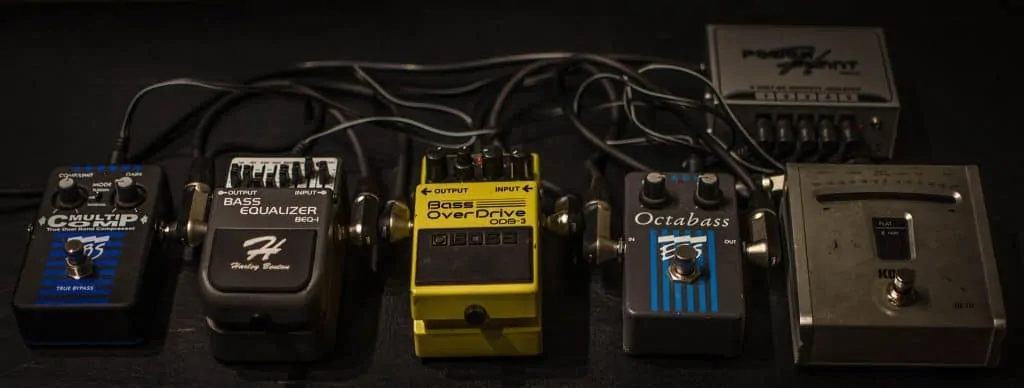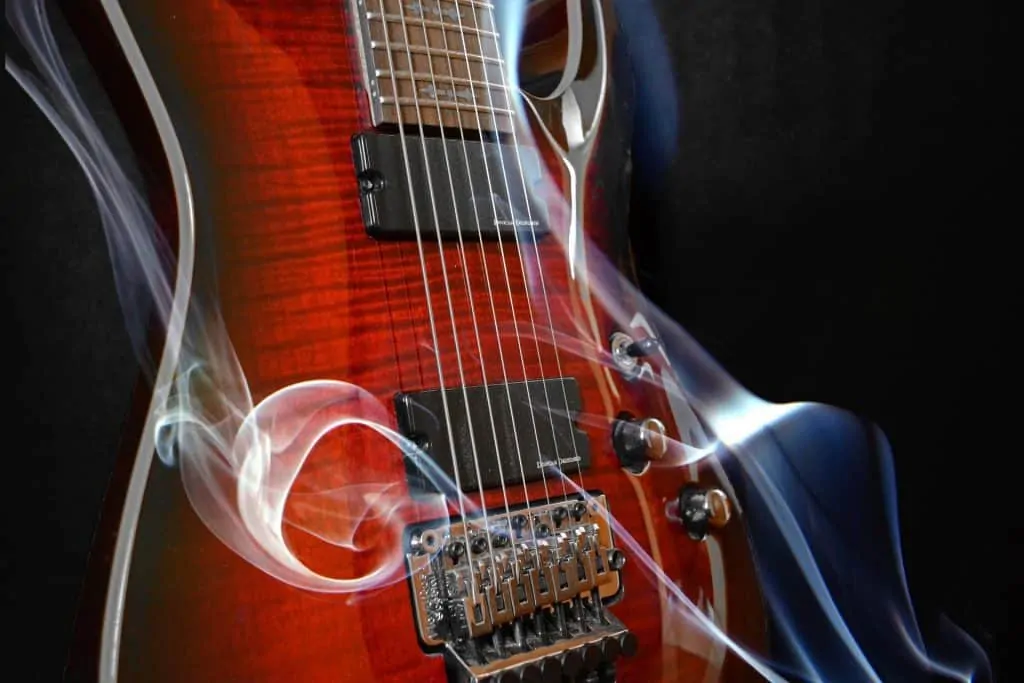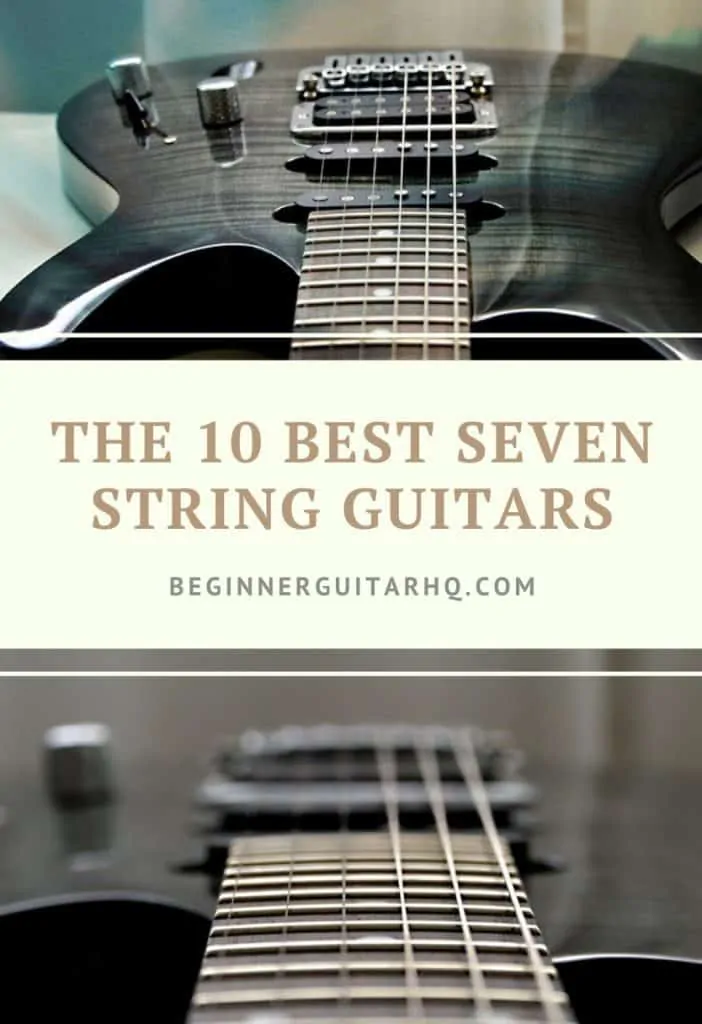At BeginnerGuitarHQ, we’re just as used to guiding you through equipment as we are actually teaching you the guitar. Once you’ve picked up some basic skills on a six-string guitar, you might find that what you want to be playing actually requires you to have a seventh string available to you.
In this important guide, I’ll talk you through 10 of the best 7 string guitars on the market.
If you’re looking to get yourself a 7-string guitar, then look no further!

Contents
First Things First
A 7-string guitar is pretty much exactly what it claims to be: a guitar with seven strings. However, there is a lot more complexity to discuss. The idea of a seventh string originated with classical guitars, where either the bass or treble range needed to be extended. This meant either the fretboard was widened and a string was added either at the top or the bottom of the guitar, or as a ‘floating’ bass, which was a single note separate from the fretboard that, as such, couldn’t be manipulated with frets.
While various models of all of the above still exist in the classical world today, this isn’t what we’re going to be looking at. The world of 7-string electric guitars is, typically, a lot more cut and dry than the differences that can be found in the classical world. The idea of a ‘floating’ string is all but unheard of on an electric guitar, and almost all 7 string electric guitars will be used to add a bass note to the bottom of the range.
Interestingly, the seven-string electric guitar began life as an important device in jazz guitar, with various hollow-bodied guitars using seven-strings in order to get a bit of extra range. In general, the tuning here remained the same as it does on the more typical metal use of today, with that bass note being used to add a B below the E of the bottom string. This B is typically the octave above the B found at the bottom of a five-string bass.
In metal, seven-string guitars have become very popular. Guitarists from just about every subgenre use them: from John Petrucci of Dream Theater, to Muhammed Suicmez of Necrophagist, to Acle Kahney of TesseracT. Interestingly, the members of Meshuggah have moved towards the even more dramatically increased range of an 8-string guitar, but we’ll stick to the seven-string models for now, in particular those that you might found being played in a metal band.
We’ll be exploring these instruments via everything from look, to playability, to feel, to sound.

Ibanez GIO RG Series, 7 String Guitar
If you’re looking for a guitar to accompany your journey through learning to play metal, then the name Ibanez is going to crop up a lot. Typically, the legendary guitar brand are known for their six-string instruments, suitable for the incredible speed and fretboard dexterity the likes of Steve Vai are most known for producing, but they have a few world-class seven string guitars too.
The GIO is one of their most affordable models, allowing you to get into territory full of low rumbling notes and sheer speed without breaking the bank. Or even coming close, to be honest. The maple neck is smooth and easy to get around, while the combination of Infinity R humbucker pickups and a F107 bridge give you the classic heavy metal tone that it’s quite likely you’re looking for.
While playability and price might be the most impressive element of this instrument, it has a surprisingly excellent tone for such a low price. Obviously, it isn’t sitting proudly at the top of its market, but you certainly won’t be disappointed with the tone you get.
Lindo LDG-7X Quilted Maple 7-String
They might not be the most famous brand of electric guitar in the world, but Lindo don’t skimp on quality. Just from looking at this instrument, you know something perfect for the stage is looking back at you. The snake eyes of the green finish just make this the exact guitar you’d want to take up on stage with you and tear through some crushing riffs or blitz your way through an unstoppably fast shred solo.
The basswood body is unconventional, but you can’t deny that Lindo know exactly what they’re doing. The resonance is all matched to a tee and the maple neck and fretboard combine to give a feel that is smooth and natural, and most importantly, really easy to get used to. The humbucker pickups add an extra layer of safety to your sound and you’ve got a three-way selector which allows you to move between neck, bridge and humbucker sounds in order to give your tone some breadth.
One of the most interesting features of this guitar is the curved neck heel. It might not be for everyone, seeing as most people learn on a much more standard guitar, but if you’re looking for speed, this is the way to do it. The ease within the guitar can rest on you means your hands and fingers will have all of the space to go wherever they want while you shred your way around.
IBANEZ RG Iron Label E-Guitar 7 String Guitar
The fact that we’re returning to the Ibanez brand so soon really does prove how much of a trusted company they are in the world of metal guitars. This one really ramps up the price in comparison to the one we’ve already looked at, but considering the incredible guitar you’ll be getting in return for your hard eared cash, this one is truly worth it.
The incredibly real-wood finish make this an absolute dream to look at, and even though this might well end up making the instrument pretty heavy for such a shred-machine, it works wonders for the tone. The maple neck is known as a Nitro Wizard, which just about sums up the type of playing you’ll be capable of with this guitar. Of course, you’re going to have to learn how to play the instrument fast first, but if this is something you need to learn, then this is certainly the place to learn it.
In terms of tone, you can muster all the warmth of a grand central melody line just as easily as you can wrangle out the dark compression needed to soar through everything from Metallica to Meshuggah. A lot of guitars end up not really needing their seventh string, but this is certainly an example of it doing wonders for the overall result. That extra low string really brings a thickness to riffs that you wouldn’t get by detuning, and the resilience of the tone when it’s played (avoiding all rumble and twang) should pretty much be exactly what you’re on the lookout for.
Cort KX500MS-SDG 7-String
Staying around a similar budget level as the Ibanez above, this entry into the market from Cort is a bold one. It decides to place its tuning pegs on either side of the headstock rather than all down one side, and the more rounded body is decidedly less evil looking than many of its cousins. However, don’t let appearances put you off.
Inside, is a tonal monster. The dexterity here is astonishing. Obviously, it has the capacity to play just about any style of metal going, but that doesn’t limit it. The crunch behind every note lends itself shockingly well to some blues licks, and if you have the right level of skill, maybe you could try accompanying yourself with some of those crushingly low notes down on the seventh string?
In terms of construction, this guitar has a Macassar ebony fretboard, a Swamp ash body and an interesting fret setup. It might take a bit of getting used to and a slight reshuffle in terms of your own hand position, but the slight curve on these frets its designed for speed and aggression. If this is the type of guitar you’re in the market for, then this should be a very good option.
Shadow SB207 7 String Guitar
As with above, don’t let appearances fool you. Sure, this guitar looks boring and bland, its colour doesn’t stand out and it pretty much looks like any regular six-string. It’s what’s going on inside that counts.
As with almost any electric guitar, your volume and tone wheel are present, as well as a three-point switch that allows you to move between pickups, including humbucker. They’ve put a lot into keeping this guitar sturdy considering the price: it feels well-built and strong even when you’re holding it, and you get the idea that it would hold up well while roaming around a hot stage.
You aren’t going to win any awards by playing it, but if you’ve got to take to the stage at a low-budget gig, then this guitar should do you pretty well.
JS Series Dinky Arch Top JS22-7
It might look similar to the one featured right above it, but this JS Series is a very different beast. The Poplar body creates a unique tone, while the very unusual Amaranth fingerboard creates a tone worlds away from the one you might expect. However, like every guitar on this list, there is a distinct nod towards a metallic tone that is easily within reach.
This Jackson guitar is powerful. You can instantly get a gritty, crunchy distortion out of it, with an impressive sustain. This means that, unlike many guitars aimed primarily at shredders, it isn’t going to stop making a sound as soon as you hit a note. You’ll be able to soar through sweeping melodies with just as much ease as you would be able to whizz around the fretboard.
There might only be two pickups (humbuckers) but they both do a great job. Down at the bridge, you’ll notice a Floyd Rose. This has a few benefits. It keeps your action nice and low, which is great for both playability and sound when knocking through speedy runs, while it also means your tuning can stay stable, even when adding some fierce bends. For such an affordable price, you’d be mad to say no to this one.
Schecter BANSHEE ELITE-7
Naming a guitar the Banshee sort of gives away the sort of vibe you’re going for. Schecter is a brand creating guitars that they want people to play fast. They want those crushing low, heavy and slow riffs to be contrasted by a shredded solo full of time signature changes and tapping, and they’ve provided a seventh string to help you along the way.
While a lot of the guitars on this list go for a distinctly metal-looking finish, the Schecter keeps things simple and natural, with a wooden body that looks like… wood! It combined maple and walnut wood in the body and neck, with an ebony fretboard providing some extra sleekness to both the finish and playability.
The hardware is all top of the range. You’ve got a humbucker at the bridge, and a very interesting type of pickup very aptly named a Sustaniac at the neck. We’ll come back to that in a second. The three-point switch allows you to change between the pickups, while you can lock your tuning with a Floyd rose and have three separate volume switches.
Anyway, back to the defining feature of this particular guitar, the Sustaniac pickup. This is a very underused (and strangely unknown, simply considering how cool it is as a concept) type of pickup that uses a magnetic field to keep the strings vibrating even after they would have stopped naturally. This means that if you’re worried about a particularly long note fading away before it has made its impact, you can quite literally select a pickup that will keep it going forever. Combine these with a lot of controls that allow a remarkable amount of control and customisation from actually on the guitar itself.
ESP E-II Horizon FR-7 – Black 7-String
We’ve finally returned to a seven-string guitar that really looks the part. Dark, futuristic colours, fret markers on the side and a jagged headstock with all seven tuning pegs lined up like they’re about to be put to death. This is a guitar you’re going to play a dissonant chord on and feel it in your soul.
The locking nut means you can activate full-on shred mode and fill your solos with bends without worrying about your instrument going out of tune, while Ebony fingerboard can be moved around on with all the speed of Steve Vai himself. In terms of tone, this is another one on this list aimed almost exclusively at shredders. If this isn’t you, maybe skip ahead, but if it is, stay tuned.
The Floyd Rose will lend itself perfectly to squealing dive bombs, while the strings and low action mean you can get a hold of some amazing pinch harmonics whenever you need them. The ability to switch between your pickups also means you have a range of tones to choose from, from that heady, trebly sound that will cut through when you need to take a solo, to the darkness of the tone that will help you forge gritty riffs down on that low seventh string.
Schecter Hellraiser C-7 Floyd Rose
Returning once more to the Schecter brand and arguably their best seven-string offering, the Hellraiser. Much like the Banshee above, this is a name that really pushes forward the metal-centric nature of the instrument.
This guitar has been positively reviewed almost across the board thanks to the quality of just about every element of its existence. The stability of tuning thanks to a mahogany neck and locking nut; the clean tones when played plugged in; and even its acoustic sound. Many have explained that this guitar, while obviously designed for the stage and a huge amp, can be great for practice. For an unplugged electric guitar, the acoustic tone is loud and fat, with sustain to match its plugged state.
It is obviously the overdriven tone that we’re focusing on, though, and Schecter have almost perfected the formula. Huge sustain and a soaring ability to combine chugging low notes on that bottom string with the screech of the highest frets. However, those highest frets are the only problem the instrument has. If you’re going to need the absolute top end of the instrument, then this might not be for you: the three frets at the very bottom of the neck are a little hard to access, meaning you have to end up in a crab-like hand shape to play them. Not ideal.
Sterling By MusicMan 7 String Guitar
This is the only signature guitar we have on this list, which probably means it is the best signature seven-string around. John Petrucci is most well-known for being the lead guitarist in Dream Theatre, a band known for some incredibly technically complex works full of immense speed, detailed control over metric changes and some crushingly heavy moments that are offset by sweet choruses and movements through various genres. It would be an understatement, then, to suggest that those using this guitar would be able to craft a tone that suits just about anything you could ever want to play.
Interestingly, this guitar has gone beyond its association to John Petrucci and has simply become a very well-loved seven-string instrument. The basswood body is incredibly heavy, but this weight is just a sacrifice you have to make for the incredible thickness and resonance of its tone, whether plugged in or played acoustically. The locking tuning system means you can stay in tune even when ripping through a twenty-minute prog epic, while the thin, flat neck allows you to form a very comfortable hand position for when you need to zoom through lead lines.
The humbucker pickups allow for a good sustain, with a mid-range boost meaning you get a thick, powerful and unique tone. Despite having this slightly bassier effect to them than you may expect, the instrument remains full of incredible clarity, even when absolutely full of distortion.
There is very little that can be said negatively about this seven-string, but if the Petrucci-specific association puts you off, please don’t let it: it’s so much more than that.
In Conclusion…
A 7-string guitar is useful in a very specific situation. If you truly need to be able to visit frequencies lower than a standard guitar can provide (that is, about a drop-C tuning) then the best 7 string guitars definitely worth an investment. Progressive metal and some incredibly heavy stuff could definitely do with that crushingly low seventh string.
However, you need to remember that it’ll change a lot for you. All of the chord shapes you’re used to will now have to be approached in a different way and your melodic playing will have to make room for the wider neck than you’re used to. As such, I’d very strongly recommend against using a seven-string guitar in a situation where you actually don’t need the seventh string. If you find yourself almost exclusively playing above the fifth fret of the seventh string, then it doesn’t need to be there at all, does it?


